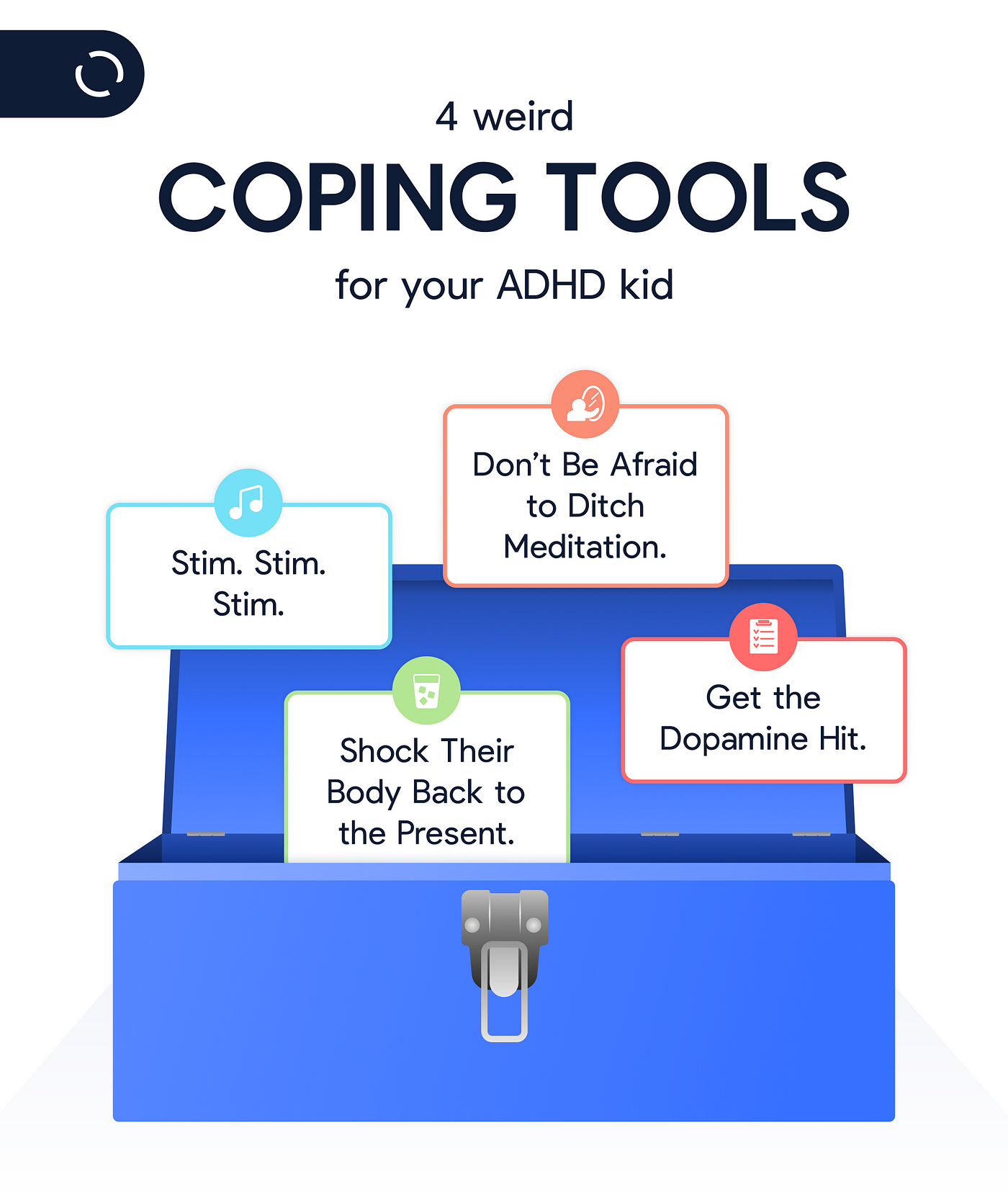I remember the moment with perfect clarity. My husband and I were in the process of sliding a dresser into our bedroom.
“Okay, first pull it back, then shift it right, then left. We’ll get it right into place,” he said.
I heard, “okay, place, we’ll, back.” The rest of the words flooded into my brain in a rush. Trying to make sense of their meaning and put them into a coherent chain brought on a swirl of confusion and rushing in my ears. I burst into tears, feeling completely overwhelmed and deeply stupid.
A month later, I saw my psychiatrist of six years and was diagnosed with severe ADHD. We’d seen warning signs the previous year but held off using medication because I wanted to try every holistic and natural solution possible first. I gave it my best shot for six miserable months but that moment with the dresser was my breaking point. I couldn’t keep going without help from meds.
Before I started medication, I thought it was normal to feel 100% overwhelmed EVERY moment of the day. When I began medication, the wash of calm and focus was shocking. Now, I know. Medication may not be your choice for your kid and that’s okay. It doesn’t “fix” my ADHD anyway; it’s only one piece of the puzzle.
When I was diagnosed, I threw together a tool kit of unique coping strategies because I was still struggling, even though I was managing my diet, exercise, and sleep every day according to conventional wisdom. I needed different tools so I designed some just for me and my brain.
Some days, I don’t need the tools. On others, I’ll grab one or two that I need. And lastly, there are days I use every single tool and still feel overwhelmed and anxious from the hurricane in my head. They don’t fix everything.
But, may I crack open the toolbox and share them with you?
These tools may or may not work for your kid. They might need some tweaks to fit their life. And conventional ADHD coping tools can absolutely help! But can we both agree it’s better to have a host of coping tools to choose from for your kid than none at all? Okay, cool.
Here are my four most unique strategies:

Don’t Be Afraid to Ditch Meditation. Develop Self Awareness.
I know. I know. I literally just told your kid it’s ok not to meditate, the one thing that everyone says they MUST do for their mental health.
Here’s why. The ADHD brain processes emotions and thoughts differently so it experiences this fun thing called Executive Dysfunction. In four words, it means “the brain shuts down.” Logical processes go offline as the pre-frontal cortex is flooded with TOO much, ALL at once. I physically feel it as a tightening in my throat, a rushing in my ears, and a pounding in my head (does it surprise you that I was misdiagnosed with anxiety years ago?).
I’ve tried to meditate in such a state and it’s always a snowball effect: my inability to focus creates frustration that intensifies the feeling of overwhelming chaos. Now, for many, meditation is an incredible tool to manage their ADHD. Try it out with your kid and see! It might be the perfect solution to restoring their inner sense of calm. However, it produced the opposite effect for me so I felt “broken” and abnormal. When I finally had the courage to ditch conventional wisdom, I found what I needed.
Instead of meditating, I spent my time developing better self-awareness.
Remember those physical symptoms I told you about? Now I tune into them as warning signs and have less dysfunctional episodes because I can feel them sneaking up. When I sense them, I stand up, assess what task is causing the oncoming rush of overwhelm, and set it aside for five minutes to think about something that makes me smile (mostly my goofy dog). The movement, the distraction, and the smile all bring my logical brain back online.
My body tells me when I’m teetering on the edge. Your kid's will too. It might take some time to discover those symptoms but you can help your kid develop the internal ear to listen for them.
Get the Quick Dopamine Hit.
If your kid has ADHD, you know they experience the existential terror of the TO-DO list. The thought of starting becomes physically painful as the logical brain goes offline and suddenly they’re running away.
Here’s a little secret: their brain craves dopamine differently than a non-ADHD brain. So, learn to hack it!
Every week, I list out every single thing I need to do. That sucks. But, before the feeling of being overwhelmed sets in, I slash whatever tasks aren’t necessary and clump the rest together by day. Now, I’m looking at a list of five real tasks per day instead of a list of 25. That’s not the end, though. For each day, I organize the tasks in terms of increasing difficulty and start with the easiest one.
First up, a quick dusting session! Without fail, I get a rush of dopamine when I check that box off my list and see a little order in my house. Now that my brain is starting to feel pretty great, I jump to the next hardest one. By the time I get through the third task, my brain is practically yelling, “Look at how amazing I am!”. That’s when I tackle the massive writing project for work because I’m feeling REALLY good about what I can accomplish.
So, go for it.
Get rid of any extra tasks you can.
List out what’s left in order of increasing difficulty.
Help your kid chase that quick dopamine hit by ticking the first few boxes and let it carry them all the way to tackling the dreaded homework assignment.
Shock Their Body Back To the Present.
Sounds dramatic, right? This one is actually the simplest tool I have.
I grab something really cold and hold on for dear life.
The science is simple. Feeling overwhelmed and panicked causes your kid’s vagus nerve (the nerve that regulates their emotional state) to go offline. Help shock them out of it by having them clutch something cold and focus ONLY on the chill.
It could be a handful of ice.
A frozen water bottle.
A scoop of snow.
Whatever it is, have them focus on the cold and take some deep breaths. Let the cooling sensational flow through them, bringing stillness to the areas that feel like chaos strapped to a rocket engine.
Trust me, it works.
Stim. Stim. Stim.
If you’ve never heard about this as a coping technique for ADHD, you’re not alone. This was the last tool I learned but it’s my favorite.
At its core, stimming is a series of repetitive physical or audible behaviors. While it’s commonly associated with autism, it’s just as helpful when I feel myself succumbing to my ADHD executive dysfunction, and (bonus!) it’s highly customizable.
Before I learned to stim, I’d step onto a sports field and my mind would overload. I’d sprint away, leaving my nephew searching for me in the stands. Determined to make it through his t-ball games, I dug into research and the answer cropped up. Music! I threw together a playlist of songs that always makes me smile.
Now, whenever the rushing starts in my ears, I put in my AirPods and hum along to the songs, focusing on the physical sensation until calm returns. If I’m at home, I put in my AirPods and loudly flex my off-key singing muscles while dancing around the room. The humming and combination of movements release all that pent-up chaos energy so I settle into a calmer state.
At work, I’ve adapted my solution because I can’t ditch a meeting to dance around the office, singing at the top of my lungs (and I don’t want my co-workers to think I’m crazy). Just a simple tweak and I have a non-disruptive solution. Whenever I start to feel overwhelmed, I quietly rub my thumb and forefinger together, focusing on the physical warmth and the texture of my fingers rubbing together. By centering my attention on the immediate and physical NOW, the tightness in my throat eases, the rushing subsides, and I quickly bounce back.
So, try it for your kid!
Create an SOS playlist of music that makes them feel like dancing.
Find something involving a physical sensation and cater it to their needs so they can self-soothe without disrupting their class.
Does it sound a little crazy? Sure, but trust me. I’d rather sound a little crazy and feel calm than act a little crazy and feel overwhelmed.
So, there you go.
My four favorite tools are weirdly and authentically mine. Hopefully, you and your kid will find them useful too! Even if you don’t, never be afraid to get outside the box and create strategies that work uniquely for them. It’s their brain, after all. They know it best and now you know that, with the right tools, they no longer have to feel overwhelmed 100% of the time.
